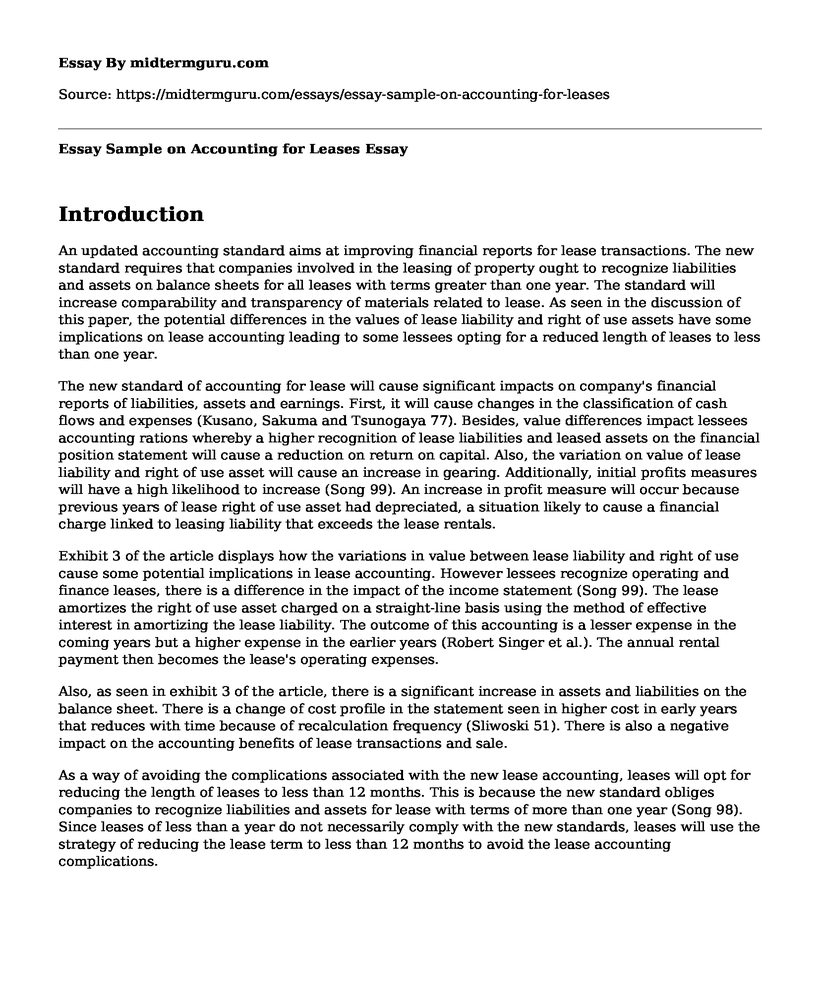Introduction
An updated accounting standard aims at improving financial reports for lease transactions. The new standard requires that companies involved in the leasing of property ought to recognize liabilities and assets on balance sheets for all leases with terms greater than one year. The standard will increase comparability and transparency of materials related to lease. As seen in the discussion of this paper, the potential differences in the values of lease liability and right of use assets have some implications on lease accounting leading to some lessees opting for a reduced length of leases to less than one year.
The new standard of accounting for lease will cause significant impacts on company's financial reports of liabilities, assets and earnings. First, it will cause changes in the classification of cash flows and expenses (Kusano, Sakuma and Tsunogaya 77). Besides, value differences impact lessees accounting rations whereby a higher recognition of lease liabilities and leased assets on the financial position statement will cause a reduction on return on capital. Also, the variation on value of lease liability and right of use asset will cause an increase in gearing. Additionally, initial profits measures will have a high likelihood to increase (Song 99). An increase in profit measure will occur because previous years of lease right of use asset had depreciated, a situation likely to cause a financial charge linked to leasing liability that exceeds the lease rentals.
Exhibit 3 of the article displays how the variations in value between lease liability and right of use cause some potential implications in lease accounting. However lessees recognize operating and finance leases, there is a difference in the impact of the income statement (Song 99). The lease amortizes the right of use asset charged on a straight-line basis using the method of effective interest in amortizing the lease liability. The outcome of this accounting is a lesser expense in the coming years but a higher expense in the earlier years (Robert Singer et al.). The annual rental payment then becomes the lease's operating expenses.
Also, as seen in exhibit 3 of the article, there is a significant increase in assets and liabilities on the balance sheet. There is a change of cost profile in the statement seen in higher cost in early years that reduces with time because of recalculation frequency (Sliwoski 51). There is also a negative impact on the accounting benefits of lease transactions and sale.
As a way of avoiding the complications associated with the new lease accounting, leases will opt for reducing the length of leases to less than 12 months. This is because the new standard obliges companies to recognize liabilities and assets for lease with terms of more than one year (Song 98). Since leases of less than a year do not necessarily comply with the new standards, leases will use the strategy of reducing the lease term to less than 12 months to avoid the lease accounting complications.
Conclusion
Conclusively, from the discussion above it is evident that the new accounting standard offers flexibilities, transparency, and comparability in the structure of lease transactions. The requirement of the standard has implications on lease accounting. The new lease accounting requirements has significant impacts on company's financial reports of liabilities. In avoiding the lease accounting complications, lessees opt to reduce the lease period to less than a year.
Works Cited
Kusano, Masaki, Yoshihiro Sakuma, and Noriyuki Tsunogaya. "Economic Consequences Of Changes In The Lease Accounting Standard: Evidence From Japan." Journal of Contemporary Accounting & Economics 12.1 (2016): 73-88. Web.
Robert Singer, CPA et al. "Accounting For Leases Under The New Standard, Part 1 - The CPA Journal." The CPA Journal. N.p., 2018. Web. 30 Oct. 2018.
Sliwoski, Leonard J. "Understanding The New Lease Accounting Guidance." Journal of Corporate Accounting & Finance 28.4 (2017): 48-52. Web.
Song, Xiaofei. "Changes In Lease Financing Practice During Lease Accounting Standard Overhaul (2005-2014)." Journal of Business and Policy Research 11.2 (2016): 94-112. Web.
Cite this page
Essay Sample on Accounting for Leases. (2022, Sep 19). Retrieved from https://midtermguru.com/essays/essay-sample-on-accounting-for-leases
If you are the original author of this essay and no longer wish to have it published on the midtermguru.com website, please click below to request its removal:
- Evolution of the Garment Industry - Essay Sample
- Information Governance: Ensuring Data Security and Responsible Use - Essay Sample
- Blockchain & Bitcoin: Revolutionizing Global Commerce & Finance - Essay Sample
- Pets at Home Plc Cash Flows: Increase Between 2014-2018 - Essay Sample
- Essay Sample on Ecclesial Organization
- Ascena Strategy of Acquisition - Research Paper
- Improve Performance With DMAIC: A Six Sigma Process - Essay Sample







